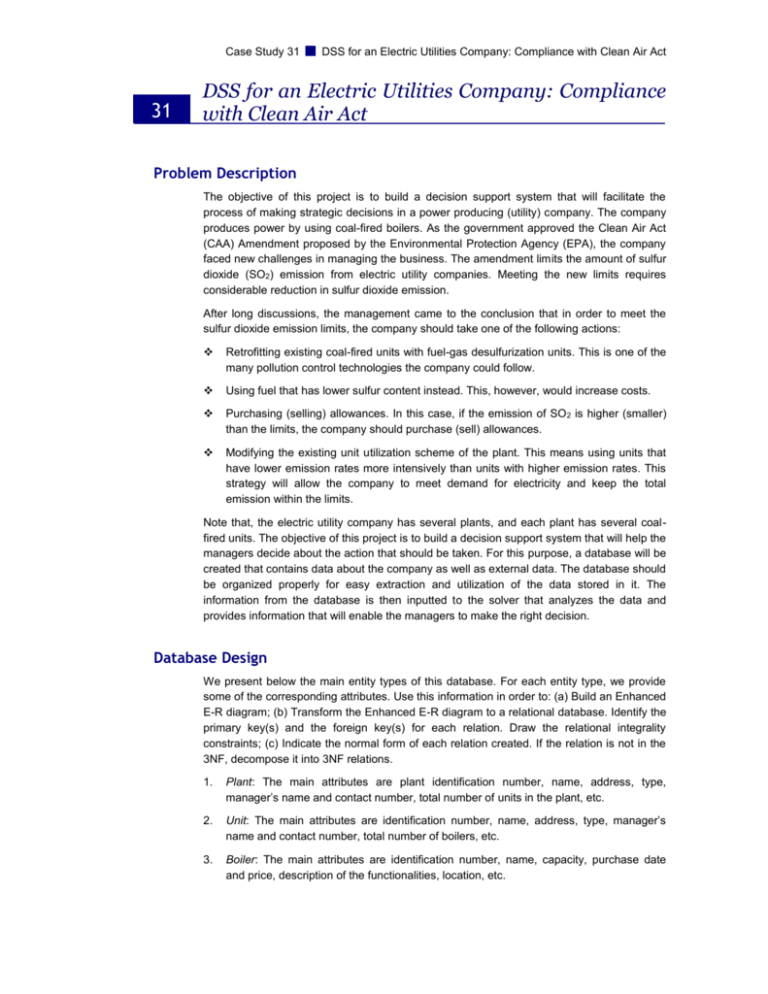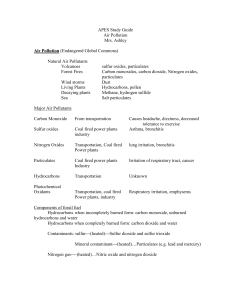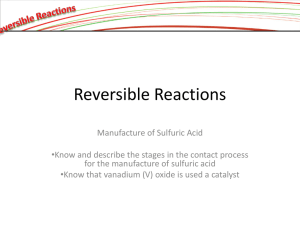DSS for an Electric Utilities Company: Compliance with
advertisement

Case Study 31
31
DSS for an Electric Utilities Company: Compliance with Clean Air Act
DSS for an Electric Utilities Company: Compliance
with Clean Air Act
Problem Description
The objective of this project is to build a decision support system that will facilitate the
process of making strategic decisions in a power producing (utility) company. The company
produces power by using coal-fired boilers. As the government approved the Clean Air Act
(CAA) Amendment proposed by the Environmental Protection Agency (EPA), the company
faced new challenges in managing the business. The amendment limits the amount of sulfur
dioxide (SO2) emission from electric utility companies. Meeting the new limits requires
considerable reduction in sulfur dioxide emission.
After long discussions, the management came to the conclusion that in order to meet the
sulfur dioxide emission limits, the company should take one of the following actions:
Retrofitting existing coal-fired units with fuel-gas desulfurization units. This is one of the
many pollution control technologies the company could follow.
Using fuel that has lower sulfur content instead. This, however, would increase costs.
Purchasing (selling) allowances. In this case, if the emission of SO 2 is higher (smaller)
than the limits, the company should purchase (sell) allowances.
Modifying the existing unit utilization scheme of the plant. This means using units that
have lower emission rates more intensively than units with higher emission rates. This
strategy will allow the company to meet demand for electricity and keep the total
emission within the limits.
Note that, the electric utility company has several plants, and each plant has several coalfired units. The objective of this project is to build a decision support system that will help the
managers decide about the action that should be taken. For this purpose, a database will be
created that contains data about the company as well as external data. The database should
be organized properly for easy extraction and utilization of the data stored in it. The
information from the database is then inputted to the solver that analyzes the data and
provides information that will enable the managers to make the right decision.
Database Design
We present below the main entity types of this database. For each entity type, we provide
some of the corresponding attributes. Use this information in order to: (a) Build an Enhanced
E-R diagram; (b) Transform the Enhanced E-R diagram to a relational database. Identify the
primary key(s) and the foreign key(s) for each relation. Draw the relational integrality
constraints; (c) Indicate the normal form of each relation created. If the relation is not in the
3NF, decompose it into 3NF relations.
1.
Plant: The main attributes are plant identification number, name, address, type,
manager’s name and contact number, total number of units in the plant, etc.
2.
Unit: The main attributes are identification number, name, address, type, manager’s
name and contact number, total number of boilers, etc.
3.
Boiler: The main attributes are identification number, name, capacity, purchase date
and price, description of the functionalities, location, etc.
Case Study 31
4.
DSS for an Electric Utilities Company: Compliance with Clean Air Act
Coal: The main attributes are name, sulfur content (SO2/lb), unit cost, price of
purchasing a unit of allowance, scrubber rate, etc.
Note that when the boiler is fired to burn coal, the following data is recorded: boiler status,
coal burning rate (in loads burned per hour), amount of coal to be burned, heat rate, amount
of sulfur emitted, etc.
Access Application Development
The following are some of the queries, forms, and reports one can create in order to
increase the functionality of the database:
Queries:
1.
2.
The following queries help to identify whether the company is currently complying with
the CAA Amendment.
a.
Create a query that calculates the total amount of coal burned in all the plants
during the current year.
b.
Create a query that calculates the total amount of energy generated from all the
plants during the current year.
c.
Different types of coal have different sulfur content. Consider this fact when
creating a query that calculates the total amount of sulfur emitted from this
company in the current year.
The following queries help the management identify strategies to be followed in order to
comply with the CAA Amendment:
a.
Create a query that prompts for the name of a plant and presents the name of the
units located in this plant. For each unit, present the following: the total amount of
coal (per coal type) burned during the current year and the total amount of sulfur
emitted in the current year.
b.
Create a query that prompts for the name of a unit and presents all the boilers
located in this particular unit. For each boiler, present the following: the total
amount of coal (per coal type) burned during the current year and the total amount
of sulfur emitted in the current year.
c.
The management believes that there is a positive relation between the age of a
boiler and emission rate. If this is the case, the management will consider replacing
some of the existing boilers. Create a query that prompts for the name of a coal
type and presents the following for each boiler in the database: (a) the actual
amount of sulfur emitted from burning the particular coal type, and (b) the
corresponding age. Sort the information by boiler age.
d.
The management is considering replacing existing coal-fired units with fuel-gas
desulfurization units. Use a make-table query to create a new table tblFuelBoiler.
The main fields of this table are as follows: identification number, name, capacity,
purchase date and price, description of the functionalities, etc. Create a query that
counts the coal-burning boilers that are at least five years old. Create another query
that calculates the total cost of replacing the old (older than five years) coal-burning
boilers with fuel-burning boilers.
e.
Create a query that lists all the different types of coal that can be used. For each
coal type, present the following: name, amount of sulfur per unit of coal, and unit
price.
Case Study 31
3.
DSS for an Electric Utilities Company: Compliance with Clean Air Act
Different coal types have different burning rates and sulfur emission rates. Having
knowledge of the total energy generated in the current year, create a query that prompts
for the name of a coal type and presents the total amount of this type of coal needed to
satisfy the demand for energy. The query should also calculate the total sulfur dioxide
that would be generated from burning this type of coal.
Forms:
1.
Create a user sign-in form together with a registration form for new users.
2.
Create the following data entry forms that are used for database administrative
functions: plants, boilers, coals, etc. These forms allow the user to add, update, and
delete information about plants, boilers, coals, etc.
3.
Create a form that allows the user to select the name of a plant from a combo box.
Create a subform that presents the following information about the selected plant:
name, address, total number of boilers, total amount of coal burned in the current year,
and total amount of sulfur dioxide emitted in the current year. Create another subform
that lists the names and addresses of all unit of this plant. Insert a command button that,
when clicked on, returns the name of the plant that has the minimum sulfur dioxide
emission rate.
4.
Create a form that allows the user to select the name of a unit from a list box. Create a
subform that presents the following information about the selected unit: the name,
address, total number of boilers, total amount of coal burned in the current year, and
total amount of sulfur dioxide emitted in the current year. Create another subform that
lists the name and location of all boilers of this unit. Insert a command button that, when
clicked-on, returns the name of the unit that has the minimum sulfur dioxide emission
rate.
5.
Create a form that allows the user to select the name of a boiler from a combo box.
Create a subform that presents the following information about the selected boiler:
identification number, name of the unit it belongs to, name of the plants it belongs to,
total amount of coal burned in the current year, and total amount of sulfur dioxide
emitted in the current year. Insert a command button that, when clicked-on, returns the
name of the boiler that has the minimum sulfur dioxide emission rate. Insert another
command button that, when clicked-on, returns the name of the ten oldest boilers.
6.
Create a form that allows the user to select the name of a coal type from a list box.
Create a subform that presents the following information about the selected coal type:
name, sulfur content (SO2/lb), and unit cost. Insert a command button that, when
clicked-on, presents the total amount of coal (of the selected type) burned during the
current year and the corresponding total purchase cost. Insert another command button
that, when clicked-on, presents the name and unit cost of the coal that has the minimum
sulfur content.
7.
Create a form that would allow the user to define different scenarios about the type of
coal to be used and corresponding quantity and calculate the total energy generated
and sulfur dioxide emitted.
Design a logo for this database. Insert this logo in the forms created above. Have the
background color of the forms light yellow and the border color for the titles green. Include
the following in the forms created: record navigation command buttons, record operations
command buttons, and form operations command buttons as needed.
Case Study 31
DSS for an Electric Utilities Company: Compliance with Clean Air Act
Reports
1.
Create a summary report for the company. The report should contain the following: the
company’s name, total number of plants, total number of units, total number of boilers,
total energy produced, total sulfur dioxide emitted, total production cost, etc.
2.
Create a summary report for each plant. The report should contain the following: the
plant’s name, total number of units, total number of boilers, total energy produced, total
sulfur dioxide emitted, total production cost, etc.
3.
Create a summary report for each unit. The report should contain the following: the
unit’s name, total number of boilers, total energy produced, total sulfur dioxide emitted,
total production cost, etc.
4.
Create a summary report about the boilers used. The report should present the
following: boilers’ identification number, name of the unit and plant it belongs to,
purchase date, and cost, age, capacity, etc.
5.
Use the chart wizard to plot the following:
a.
The total energy produced per year in the last ten years.
b.
The total sulfur dioxide emitted per year in the last ten years.
c.
The total number of boilers used per year in the last ten years.
d.
For the company’s ten oldest boilers, present the total energy produced and total
sulfur dioxide emitted (per unit of coal used) per year in the last ten years.
Visual Basic.NET Application Development
This database application can be used by managers, database administrators, etc. In the
following figure we present a tentative layout of the system.
Welcome Screen
Plants, Units
& Boilers
Coal
Statistics,
Graphs & Data
Analysis
Updates
Login
Req.
Present Results
Exit the Database
K T
K T
K T
min : ckt xkt hkt I kt Fkt z kt
k 1t 1
k 1t 1 Case Study
k 131
t 1
DSS for an Electric Utilities Company: Compliance with Clean Air Act
Subject to :
K
zkt 1
k 1
xkt I k ,t 1 I kt d kt
xkt Pkt z kt
xkt , I kt 0
z kt {0,1}
In the welcome screen, the user can choose one of the four options presented. We give
details aboutfor
thet forms
in each option; however, you are
1,...,orTset
, of forms to be included
(1)
encouraged to add other forms you find important. We suggest that the queries, forms, and
reports already created in the Access Application Development section be included in here.
for k 1,..., K ; t 1,..., T ,
(2)
Plants, Units & Boilers: The management browses this part of the database to identify: (a)
forenergy
k 1,...,
K ; t in1,...,
T , plants,
(3) units, and boilers; (b) the amount of
the amount of
generated
different
sulfur dioxide for
emitted
in,...,
different
k 1
K ; t plants,
1,..., Tunits,
, and
(4) boilers; (c) the boilers that need to be
replaced; etc.
for k 1,..., K ; t 1,..., T .
(5)
Coal: This part of the database keeps useful information that helps the managers identify the
type of coal and quantity to be used in order to satisfy demand for energy at minimum cost
without violating the sulfur dioxide emission limits set by the CAA Amendment.
Statistics, Graphs & Data Analysis: This part of the database is investigated in order to
identify trends in: (a) the total energy demanded; (b) the total sulfur dioxide emission; etc.
Update: The update form requires an administrator login name and password. This form
allows the user to add/delete/update the information kept in this database about plants,
units, boilers, coal, etc.
Web Extension
A user may access this database from personal computers at home or in the office. The user
could be a manager, the database administrator, etc. The managers use the database to
identify opportunities that would enable the company to satisfy demand for energy at the
minimum cost without violating the limits set by the CAA Amendment on the total sulfur
dioxide emission. Only the database administrator can have access to the update forms.
Develop an ASP.NET web application that will enable the users to access the database and
perform the activities described above. Your application will have forms similar to the ones
described in the VB.NET Application section.
Reference
Ghandforoush, P., Sen, TK., Wander, M., “A decision support system for electric utilities:
compliance with Clean Air Act.” Decision Support Systems 26: 261-273, 1999.






